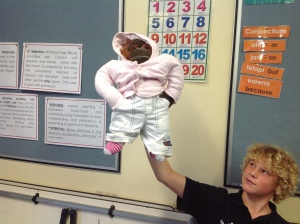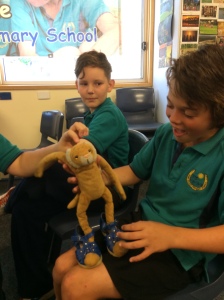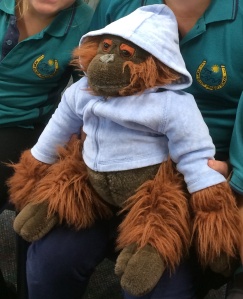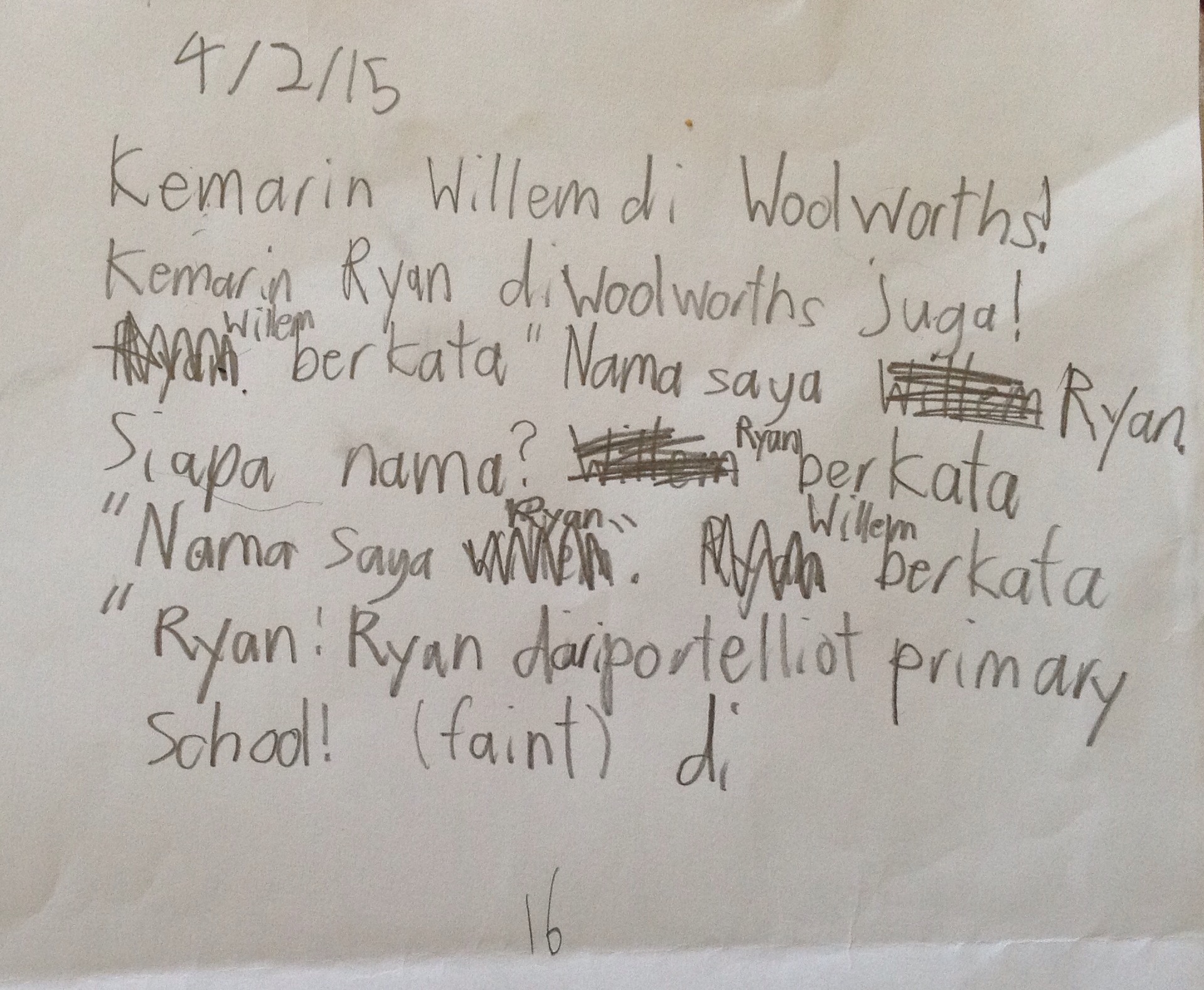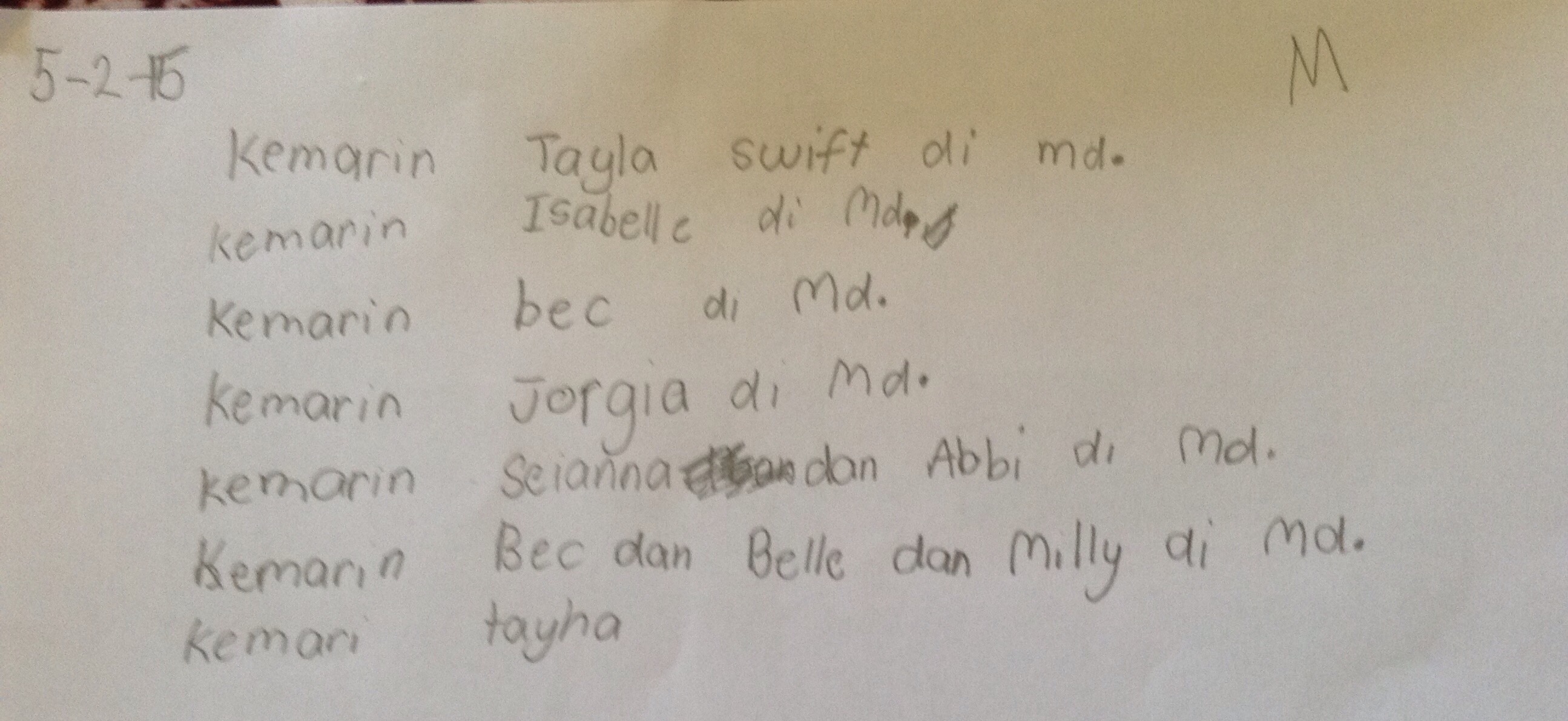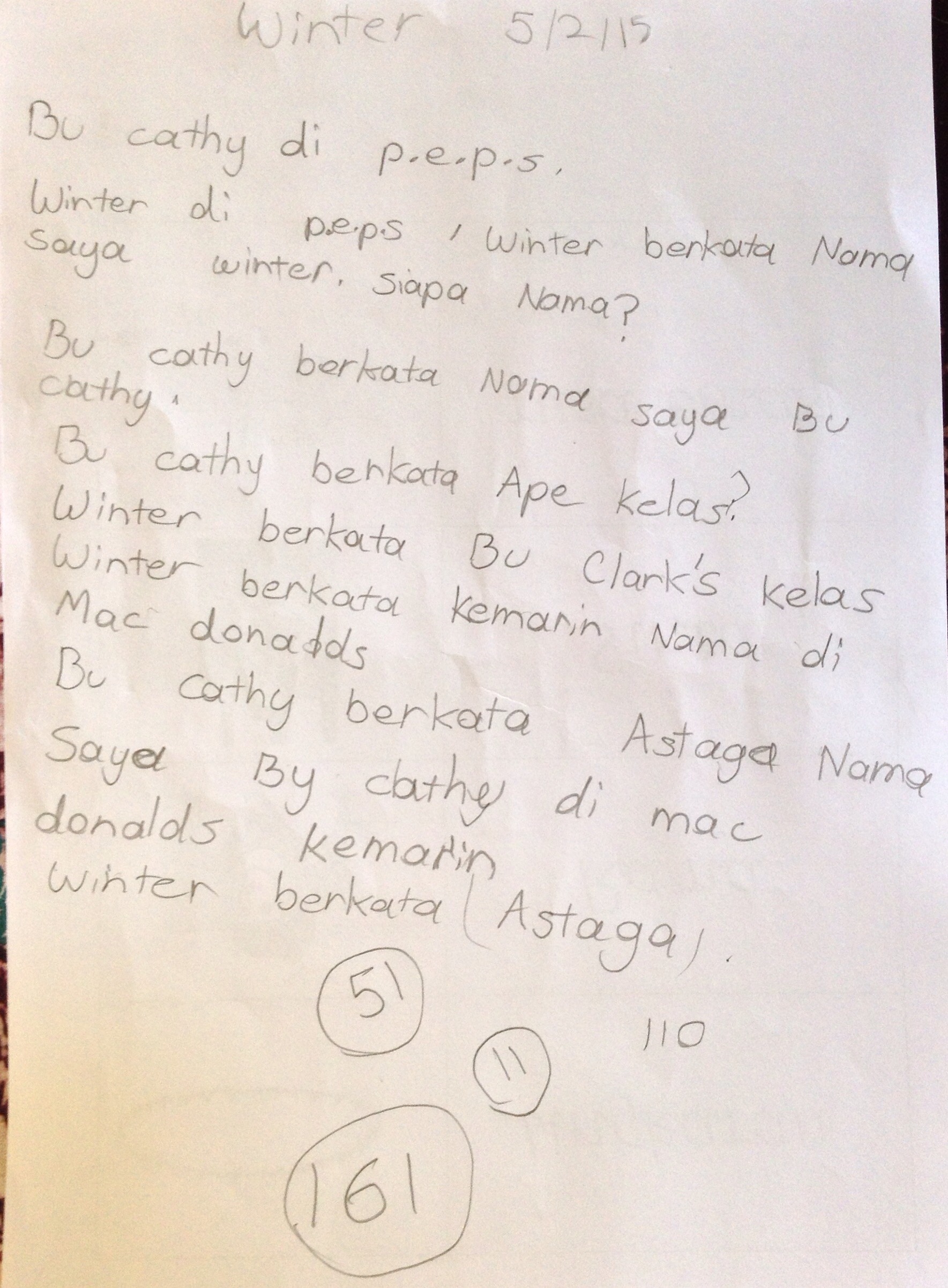At our (Indonesian Teachers Hub Group) last meeting, Annie mentioned that she is focusing on the skill of circling at the moment. Circling is an integral skill in TCI and I suddenly realized that it had not been a focus lately in my recent lessons. I then decided that I too needed to hone my circling skills and so determined to incorporate more circling into my lesson plans.
I refreshed my understanding of it by reading various sites and as always, I started with Martina Bex’s website. There she has a link to a pdf she created about circling. Here are 2 great sentences from the pdf to clarify the definition and purpose of circling:
DEFINITION
Circling is the instructional practice of asking a series of prescribed questions in the target language about a statement in the target language.
PURPOSE
Circling is used to provide students with contextualized repetitions of target structures.
Circling has a recommended format yet it is not set in stone. It must be driven by the students so that teacher input is compelling (i.e. truly interesting) and thus relevant to the students. Here is a recent moretprs post from Dr Krashen about ‘compelling’ and ‘relevance’:

Circling is a powerful TCI strategy which ensures students are engaged and acquire language totally without realising!
The circling format includes the following:
Statement
Question
Either/or
Negative
3 for 1
Ask a detail
[Optional are:
Who, What, When, Where, Why]

courtesy Martina Bex’s Website
Using this format, I wrote circling questions into my lesson plans focusing on each of the above steps to prompt my memory and help develop my circling proficiency. I tend to find that when I am in front of a class, my mind goes blank whenever improvisation is needed!! Hopefully this is something that will reduce as I gain confidence and experience with TCI methodology.
I initially had the above poster up on the back wall but it didn’t help. For example I would see the word ‘interrogative’ and just freeze like a rabbit in the spotlight! So instead I incorporated a circling mini block into each lesson:
Circling # 1 –
Junior Primary
a) Indie perempuan. (statement)
b) Indie pakai sepatu? (ya) Ya, Indie pakai sepatu.
c) Indie pakai sepatu atau Indie pakai jaket? (either/or) Indie pakai sepatu.
d) Indie pakai topi? (ya/tidak) Bukan. Indie pakai sepatu.
e) Indie minum/makan sepatu? (3 for 1) Bukan! Indie pakai sepatu, Indie tidak minum sepatu!
Middle Primary & Upper Primary
1. Flick berkata. (statement)
2. Flick berkata? (ya) Ya, Flick berkata.
3. Flick berkata kepada Ella. (ya/tidak) Ya. Flick berkata kepada Ella.
4. Flick berkata kepada Ella atau Flick berkata kepada Thomas? (either/or) Flick berkata kepada Ella.
5. Kenapa Flick berkata kepada Ella? (extra detail) Flick berkata kepada Ella karena ? (mau ke McD, dingin,)
6. Circle new detail.
This amount of detail was so helpful. I could refer to my notes at any point to ensure I covered all aspects when/if necessary. Writing it too helped clarify in my mind so that my response should always be either the initial sentence or include the initial sentence!
I felt that at last I was getting a handle on circling! Then with brilliant timing, several TCI teachers wrote blogs posts specifically about circling. Keith Toda posted on his blog, Todally Comprehensible Latin, Circling – The Art of Questioning and Chris Stoltz posted on TPRS Q & A his post ‘What is Circling and How Do I Do it?’ Both are great and I highly recommend you read them to grasp the finer details of circling.
After reading Chris Stoltz’s post I asked him a question and he replied:

When I first read his reply, I was taken aback by its brevity and once I had recovered, I started to think about his point. If I was to circle only what students didn’t understand, then I was going about “circling” the wrong way.
The next thing that happened was again by coincidence. I had emailed Ben Slavic about micro stories suitable for primary (elementary) students. He replied with an attachment of his draft chapter called Super Mini Stories. In this chapter, Ben focuses in great detail on the skills needed to tell a story. Reading this with my trusty highlighter was illuminating. Chris’ statement ‘Circle what the students don’t understand” suddenly gelled.
Circling has to be done in context and more importantly, stories must have input from students. This is what makes TCI compelling.
Last week I trialed it and discovered the truth of the above statement. This is how I did it:
With the classes 3-7, I arranged the chairs into a circle and in the middle of the circle I put a pile of clothes for this story: (underlined words signify where I asked for student input.)
Bobby dingin. Bobby berkata kepada Ibu,”Saya dingin.”
Ibu kasih Bobby satu jaket.
Bobby pakai jaket di kaki.
Bobby masih dingin. Bobby berkata kepada Bapak, “Saya dingin.”
Bapak kasih Bobby satu baju.
Bobby pakai baju di kepala.
Bobby masih dingin. Bobby berkata kepada Kakek, “Saya dingin.”
Kakek kasih Bobby dua sepatu.
Bobby pakai sepatu di tangan.
Bobby tidak dingin lagi.
Prior to last week, I’d told the story with actors and the other students just watched and listened. However, this week, I used circling to ask for student input and it was highly compelling. Here is why:
I began with:
Siapa mau menjadi assistan Bu Cathy? (Who wants to be Bu Cathy’s assistant?)
I looked around the circle and chose someone who would be a good actor, someone who could be a ham if necessary and not get embarrassed. I then asked them to ‘berdiri’ (stand.)
Next I asked the class, “Caden perempuan atau Caden laki laki?” The class invariably answered “Caden perempuan.” To which I checked in with my actor, “Caden laki laki atau Liam perempuan?” If he answered, “Caden perempuan”, I would then confirm, “Caden perempuan!” Next I asked students, “Siapa nama Caden? ‘Caden’ nama laki laki!” Sometime, classes came up with a hilarious female version of the name (Luke became Lukette, Kody became Kodella) and sometimes they would come up with a name that has been bandied around lately. For some reason Jeff and Bob are hilarious names!! Go figure!
I then began the story:
Ada perempuan. Nama perempuan Delilah.(students decided that Caden would become his twin sister!) Delilah dingin. Delilah berkata kepada???? Delilah berkata kepada siapa? (laser pointer to ‘siapa’ poster up above the whiteboard) If students suggested the name of a fellow student, I would answer, “Bukan nama murid di kelas ini.” Because I wanted them to come up with some quirky suggestions. I would settle on the suggestion that got the most catcalls!! Justin Bieber and Tony Abbott were up there!! I next asked, “Siapa mau….. Justin Bieber?” That actor was also asked to ‘berdiri’.
I would then recommence my story from the start to throw in some sneaky repetitions.
Ada perempuan. Nama perempuan Delilah. Delilah dingin. Delilah berkata kepada… Delilah berkata kepada Justin Bieber, “Saya dingin.” Justin Bieber kasi Delilah???? At this point I rummaged through the pile of clothes on the floor and repeated the sentence several times adding the word for the article of clothing I held up, looking at ‘Justin Bieber’ to gauge both his/her reaction and the class’. “Justin Bieber kasi Delilah jaket? Justin Bieber kasi Delilah sarong? Justin Bieber kasi Delilah topi? Justin Bieber kasi Delilah jilbab?” OOnce the class agreed on the item of clothing (majority rules), I then handed the item of clothing to “Justin Bieber” and then turned to the class and asked, “Justin Bieber kasi Delilah satu jilbab atau Justin Bieber kasi Delilah dua jilbab?” Depending on their collective answer (if too noisy, I asked ‘Angkat tangan kalau Justin Bieber kasi Delilah dua jilbab”, repeated sentence again or satu jilbab, while counting in Indonesian the number of hands) then we continued the story:
Justin Bieber kasi Delilah satu jilbab.
I then stopped the acting, asked Justin Bieber to ‘duduk’ then turned around to face the class again and asked, “Delilah pakai jilbab di kaki (pointing to my foot)? Delilah pakai jilbab di tangan (pointing to my hand)? Delilah pakai jilbab di leher (pointing to my neck)?” etc until I got a popular consensus. I then repeated the sentence and the actor acted out the story. In this case it was:
Delilah pakai jilbab di kepala. Delilah masih dingin.
We continued till the end of the story this way. It was hilarious and totally compelling!! I love that TCI provides me with ways in which I can laugh with my students while teaching!!
During the day on Monday, I wrote a few notes in my notebook that I keep handy to record my reflections and this is what I wrote:
1. Circle what they don’t know!!
2. Don’t forget to ask quantity of clothing! E.g. dua sepatu!!
3. Go SLOW!! Don’t rush!! Slow and steady is how students comprehend and acquire the target structures. Make the most of each repeititon.
4. Try to make circling sound like natural speech using familiar vocabulary while incorporating all the facets of circling. E.g. negative, either/or, 3 for 1, asking for extra detail.



















